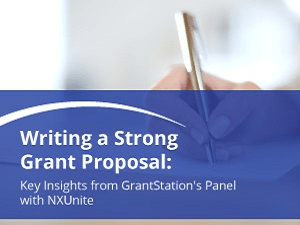
GrantStation’s President Alice Ruhnke joined NXUnite’s “Grand Grant Goals: Strengthening Your Grant Proposal” with nonprofit professionals Colton Strawser of Colton Strawser Consulting, Meredith Noble of Learn Grant Writing, and Teresa Huff of Grant Writing Simplified Podcast to provide their insights on how to determine an organization’s grant readiness and strategies towards creating a strong grant proposal.
What is Grant Readiness?
Securing funds is an important part of every nonprofit organization’s needs, but finding the funds and securing them can entail a lot of work. Before your organization begins applying for grants, it needs to determine if it’s grant ready or not. What is grant readiness? In short, a nonprofit organization’s grant readiness is its ability to search for, apply to, win, and manage grants successfully.
“As a nonprofit organization, you should have the policies and procedures in place on how you’re going to manage your finances and make sure to have your strategy established,” said Alice Ruhnke, President of GrantStation.
Next time you are reviewing your grant readiness, ask yourself the following questions:
- Have you raised money before?
- Do you understand your business model?
- Do other people already support you?
- Is everyone on the board involved?
- Is there evidence to show that your organization is a good investment?
However, if your nonprofit decides it may not be completely grant ready yet, you can look towards other alternatives such as a fiscal sponsorship.
The Key to a Strong Grant Proposal
Nonprofits rely on consistent funding and a strong grant proposal increases the likelihood for organizations to achieve the funds needed to further their mission and objectives. While there are a lot of factors that affect whether or not your grant proposal is competitive, it all starts with your organization’s preparation process.
“Preparation is key, especially in government funding. One thing to remember is that your program seeks funding, funding does not seek your program,” said Colton Strawser, President of Colton Strawser Consulting.
When it comes to preparation, Alice Ruhnke of GrantStation recommends the 80-20 rule. 80% of your organization’s time should be spent in the development phase and putting those pieces together. The other 20% should be allocated towards tying what your organization has already written to the funder’s desired format.
How to Communicate in Your Grant Proposal
When it comes to proposal writing, clear and concise communication within your proposal is important. The person reading your organization’s grant proposal should not have to spend hours deciphering what your nonprofit is trying to communicate.
“You do not want your funders to question your nonprofit’s goals and who you are,” said Meredith, the Co-Founder of Learn Grant Writing.
The following strategies will help you clearly communicate your organization’s goals the next time you are building out your grant proposal:
- include action words;
- include one measurable objective;
- include what you do and how you do it; and,
- include a tangible transformation sentence.
Funders and donors are looking for organizations to answer the “So what?” question. They are looking for an organization’s accomplishments. A successful grant proposal should communicate the changes and outcomes your organization will be able to achieve.
Resources for Your Next Grant Proposal
Overall for your organization, and specifically for grant proposals, it is important to prepare ahead of time and have a strategic approach. The next time your organization is looking for tips on proposal writing and strengthening your grant proposals, remember that there are resources such as nonprofit workshops and podcasts which can provide more insight.